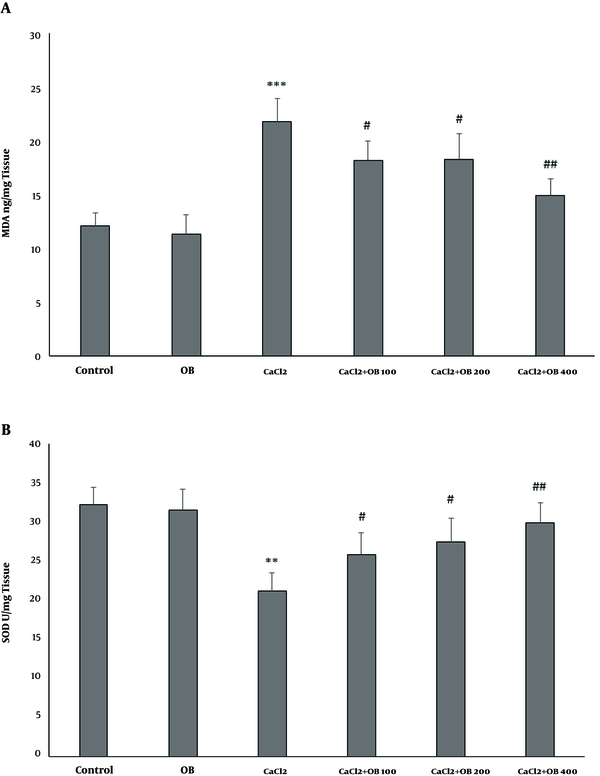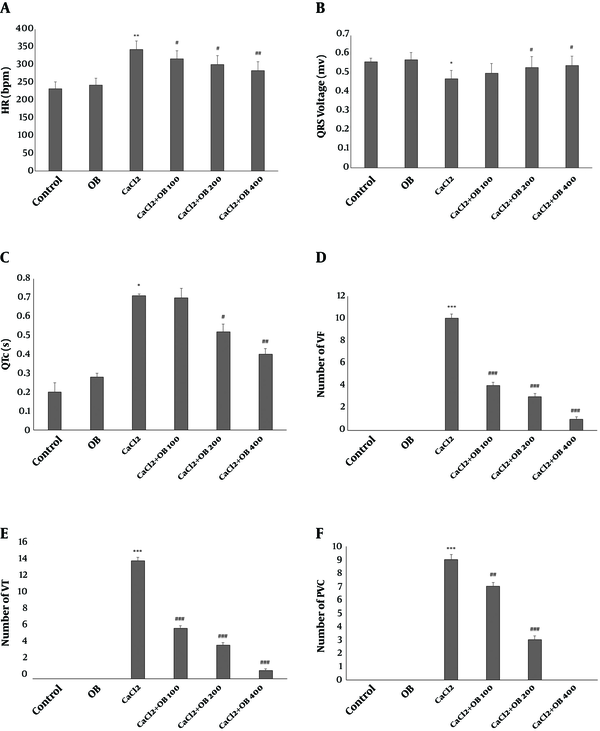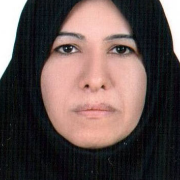Abstract
Keywords
1. Background
Cardiac arrhythmia is an abnormal heart rhythm, which may be temporary, short enough to affect the overall heart rate, or it may cause the heart to beat too fast or too slow. In arrhythmia, the heart beats too fast or too slow or has an irregular rhythm (1). Oxidative stress is strongly associated with heart disease and its complications. All types of cardiac arrhythmia are accompanied by the additional generation of reactive oxygen species (ROS). Numerous potential mechanisms are considered to generate ROS to prompt arrhythmia. Reentry can be induced by increased ROS production. Free radicals change various currents from the heart ionic channels. Excessive free radicals lead to cardiac fibrosis and gap junction dysfunction, which result in a decrease in cardiac cell coupling and an increase in reentry (2). There are some limitations for the treatment of arrhythmia, including ablation, ion channel blockers, defibrillation, and side effects of drugs. Therefore, focusing on novel anti-dysrhythmia agents seems to be important (3). Some of these limitations are related to the fact that current therapies do not consider the essential pathophysiology mechanism of cardiac arrhythmia. Oxidative stress is defined as an imbalance between the generation and neutralization of free radicals, which can be considered as a promising target for the treatment of cardiovascular diseases. Oxidative stress plays a critical role in pathologic parameters of some cardiac arrhythmias, including cardiac and thoracic surgeries, age, and hypertension (4).
Ocimum basilicum (OB) is a plant from the mint family that is consumed in large areas of the world. The most important compounds in OB are menotropins, limonene, myrcene , flavonoids, such as quercetin, camphor , rutin, and phenolic compounds, such as rosmarinic acid, lithospermic acid, and caffeic acid (5). Several studies have shown that basil has medicinal properties, such as antioxidant and free radical scavenging (6), anti-apoptotic (7), antidiabetic, (8) and anti-inflammatory (9) effects.
2. Objectives
Therefore, the current experimental study was designed to evaluate the antioxidant effect of OB extract (hydro-alcoholic) on the prevention of cardiac arrhythmias in rats.
3. Methods
3.1. Animals
Male rats (Sprague-Dawley) were divided into the control (2 weeks, normal saline, gavage) and three groups administrated with different concentrations of hydro-alcoholic extract of OB (100, 200, and 400 mg/kg, gavage for 2 weeks). The rats (eight rats in each group) had access to food and water. The procedures applied in the current experimental study were approved by the Ethical Committee of Laboratory Animals of Ahvaz Jundishapur University of Medical Sciences (No: IR.AJUMS.REC.1396.267).
3.2. Method of Preparation of Hydro-Alcoholic Extract of Ocimum basilicum
OB was grown and collected from the farm in Ahvaz and approved by the faculty member of the pharmacy of Ahvaz Jundishapur University of Medical Sciences. Then, it was washed and dried in the shade at room temperature for extraction by soaking (massage) 100 grams of the plant. The leaf was removed, and then its parts were pulverized by a mechanical mill. Then, the desired solvent (ethanol) was poured on the plant and kept in the laboratory for 48-72 h. The amount of solvent required for the plant was enough to cover the surface of the plant, and the plant particles moved easily in the solvent. After the desired time, we filtered the solution with a funnel and concentrated the extract with a rotary apparatus, and then we place it in the freezer for 48 h to completely separate the solvent from the extract and obtain a pure extract powder (10). The obtained extract powder was kept at -18 °C until use, and the extract was dissolved with distilled water and administrated to rats by gavage.
3.3. The Electrocardiogram (ECG) Recording and Inducing Arrhythmias
After anesthesia, ECG was recorded in all groups for 10 min, and ECG parameters, including HR, QRS complex voltage, and QTc were calculated. The Bazett formula was applied to measure the corrected QT interval (QTc). Then, for the establishment of an in vivo cardiac arrhythmias model, the prep and drep were done. In the second step, a surgical incision was made in the groin area, and a catheter (polyethylene) was implanted in the femoral vein. Finally, the chemical cardiac arrhythmia was generated by intravenous administration of CaCl2 (140 mg/kg), and the number of ventricular tachycardia (VT), premature ventricular beats (PVC), and ventricular fibrillation (VF) were studied in response to CaCl2 injection (11).
3.4. Assessment of Antioxidant Effect and Lipid Peroxidation Index
Evaluation of superoxide dismutase (SOD) and malondialdehyde (MDA) levels was achieved by spatial assay kits (Zell Bio Co., Germany) using cardiac tissues. The values were analyzed in accordance with the manufacturer's instructions.
3.5. Heart Histopathological Study
At the end of the experiments, the cardiac tissue was collected in all groups, and the tissue samples were fixed in formaldehyde, and finally embedded into paraffin. Then, the tissue samples were sectioned at 4 μm and stained with Hematoxylin and Eosin (H&E) to evaluate the morphological changes using the microscopic examination.
3.6. Statistical Analyzing
Data analysis was done by SPSS software and reported as mean ± SEM. The one-way analysis of variance (ANOVA) and Fisher's exact test were applied to compare groups. A P < 0.05 was considered as a statistically significant difference.
4. Results
4.1. Effect of Ocimum basilicum on ECG Parameters
The results obtained from the analysis of ECG showed that in the CaCl2-induced arrhythmias group, the prevalence of VT, VF, and PVC significantly enhanced compared with the control rats, and administration of OB for 14 days decreased the prevalence of arrhythmias, including VF, VT, and PVC. Also, the heart rate in the CaCl2 group showed a marked increase in the CaCl2 rats, which was associated with a decrease in the QRS complex voltage and an increase in QTc. Also, 2 weeks of OB (at 100 and 200 concentrations) administration caused a decrease in the arrhythmias prevalence and at the concentration of 400 mg/kg, it preserved the mentioned ECG indices in the normal levels (Figure 1).
Oxidative stress parameters in cardiac tissue. A: Malondialdehyde (MDA) and B: superoxide dismutase (SOD) levels in all groups, including control, Ocimum basilicum (OB, 400 mg/Kg), CaCl2: arrhythmias model, OB (100 mg/Kg) + CaCl2, OB (200 mg/Kg) + CaCl2, and OB (400 mg/Kg) + CaCl2. Data are expressed as mean ± SEM. **P < 0.01 and ***P < 0.001 compared with the control group and #P < 0.05 and ##P < 0.01 compared with the CaCl2 group.

4.2. Effect of Ocimum basilicum on Oxidative Stress Parameters
To evaluate the antioxidant effect of OB on the CaCl2-induced arrhythmias model, the MDA level as the index of lipid peroxidation, and the SOD content, as the index of the antioxidant defense system, were measured in the cardiac tissue samples of all groups. The results showed that CaCl2 injection caused an increase in the lipid peroxidation in the cardiac tissue samples in comparison with the controls. Also, the SOD level significantly decreased in the arrhythmias group compared with the controls. Administration of OB for 14 days led to a decrease in MDA level and a significant increase in the SOD level with the highest effect at 400 mg/kg compared with the CaCl2 group (Figure 2).
Electrocardiogram parameters, including A: HR (heart rate), B: QRS complex voltage, and C: QTc, D: the prevalence of ventricular fibrillation, E: ventricular tachycardia, and F: ventricular premature beats in all groups including control, Ocimum basilicum (OB, 400 mg/Kg), CaCl2: arrhythmias model, OB (100 mg/Kg) + CaCl2: OB (200 mg/Kg) + CaCl2, and OB (400 mg/Kg) + CaCl2. Data are expressed as mean ± SEM. *P < 0.05 and **P < 0.01, ***P < 0.001 compared with the control group and #P < 0.05, ##P < 0.01, and ###P < 0.001 compared with the CaCl2 group.

4.3. Effect of Ocimum basilicum on Cardiac Histopathology
In order to evaluate the protective role of OB on the cardiac tissue against CaCl2-induced arrhythmias, the heart sections were stained with H&E to assess the possible cardiac remodeling. In this study, there were no significant changes in the cardiac tissue morphology and structure in the CaCl2 and OB groups compared with the control rats (Figure 3).
Cardiac histopathology in all groups, including A: control, B: CaCl2: arrhythmias model, and C: Ocimum basilicum (400 mg/Kg) + CaCl2.

5. Discussion
The current study documented that OB, as a natural alternative drug, can prevent the oxidative stress damage-induced disturbances in cardiac ECG by a decrease in MDA and SOD levels.
The cardiovascular system is one of the vital systems, which when it is stopped only for a few minutes, early death can occur (12). Therefore, it is important to evaluate the factors that affect or disrupt this system. Cardiac arrhythmias are one of the factors that can affect this system's efficiency and cause dysfunction. The heart has a special system for producing regular beats. This innate and guiding system of the heart is sensitive to electrolyte disturbances, Acid-base disorders, changes in the activity of the autonomic nervous system, increased myocardial fiber contraction, myocardial ischemia, drugs, heart disease, and developing arrhythmias (13). The importance of cardiac arrhythmias in the management of anesthesia depends on the specific effect of some of these rhythm disorders on cardiac output and the interaction of antiarrhythmic drugs. Many patients develop cardiac arrhythmias during anesthesia in surgical procedures. Common cardiac arrhythmias, especially VF and ventricular tachycardia (VT) are the main general health concerns (14).
Increased ROS affects multiple ionic currents in the myocardium. Free radicals can lead to alterations in intracellular calcium and cause cardiac arrhythmias. Oxidative stress via an increase in the L-type Ca2+ current can stimulate the early afterdepolarizations. Moreover, ROS can enhance the activity of the ryanodine receptors that regulate the sarcoplasmic reticulum (SR) release of calcium to the cytoplasm, which can stimulate delayed afterdepolarization and cause cardiac dysfunction (15).
Natural antioxidants can prevent the oxidation of free radicals through inhibition of their activities, and by inactivating them, the cell can be protected from the damaging effects of these harmful molecules. OB is a plant belonging to the mint family that has been used in traditional medicine as an antiseptic and analgesic drug, and it is also recommended for the treatment of pain, respiratory diseases, and renal failure (16). Flavonoids, phenolic acid, and triterpenes are secondary metabolites in OB. The activity of phenolic compounds is related to their antioxidant properties, which plays an important role in the scavenging and inhibition of free radicals, suppression of ROS, or decomposing peroxidases (17). According to the results of the current study, administration of OB at all concentrations prevented the oxidative stress induced by CaCl2, which was detected by a decrease in MDA content and also an increase in SOD activity. These effects led to decreased cardiac injuries and preserved the normal cardiac ECG as demonstrated by a decrease in the ventricular arrhythmias in rats administrated with CaCl2 plus OB. Consistent with these results, a study by Umar et al. in 2010 showed the cardiovascular protection of OB in renovascular hypertensive rats (18). Another study by Umar et al. also documented the antithrombotic and antihypertensive effects of OB through enhanced 6-keto-PGF1α and a reduction in prostaglandin E 2 and thromboxane B2 (19). Also, Irondi et al. documented that the leaf extract of OB has an inhibitory effect on angiotensin 1-converting enzyme and pancreatic lipase (20). Moreover, Muralidharan et al. reported the cardiac inotropic and negative chronotropic actions of alcoholic extracts derived from the OB (21). According to a study conducted on five various extracts of OB, the antioxidant activity of this plant could be partially explained by the high levels of phenolics and flavonoids (22). In this regard, an in vitro study on cultured cardiomyocytes showed the antioxidant properties of OB oil and its water-soluble extract in the hydrogen peroxide- induced oxidative stress model (23). Therefore, based on the documented evidence and the results of the current study, it seems that OB, as a natural antioxidant agent, has a cardioprotective effect by reducing the oxidative stress damages against CaCl2-induced arrhythmias, which suggests the therapeutic potential of the plant in cardiovascular disorders. Due to some limitations, the measurement of the other antioxidant enzymes and molecular pathways were not done. Also, studies using different doses and time points should be done in the future.
Acknowledgements
References
-
1.
Aubin MC, Cardin S, Comtois P, Clement R, Gosselin H, Gillis MA, et al. A high-fat diet increases risk of ventricular arrhythmia in female rats: enhanced arrhythmic risk in the absence of obesity or hyperlipidemia. J Appl Physiol (1985). 2010;108(4):933-40. [PubMed ID: 20133431]. https://doi.org/10.1152/japplphysiol.01281.2009.
-
2.
Munzel T, Camici GG, Maack C, Bonetti NR, Fuster V, Kovacic JC. Impact of Oxidative Stress on the Heart and Vasculature: Part 2 of a 3-Part Series. J Am Coll Cardiol. 2017;70(2):212-29. [PubMed ID: 28683969]. [PubMed Central ID: PMC5663297]. https://doi.org/10.1016/j.jacc.2017.05.035.
-
3.
Marcus GM, Smith LM, Scheinman MM, Badhwar NITISH, Lee RJ, Tseng ZH, et al. Proton pump inhibitors are associated with focal arrhythmias. The Journal of Innovations in Cardiac Rhythm Management. 2010;1(4):85-9.
-
4.
Aviles RJ, Martin DO, Apperson-Hansen C, Houghtaling PL, Rautaharju P, Kronmal RA, et al. Inflammation as a risk factor for atrial fibrillation. Circulation. 2003;108(24):3006-10. [PubMed ID: 14623805]. https://doi.org/10.1161/01.CIR.0000103131.70301.4F.
-
5.
Divisha R, Ranganathan V, Vijayakaran K, Elamaran A. Evaluating Ocimum basilicum and Ocimum tenuiflorum leaf extracts for the presence of phenolic compounds. Journal of Pharmacognosy and Phytochemistry. 2018;7(6):2453-6.
-
6.
Gulcin I, Elmastas M, Aboul-Enein HY. Determination of antioxidant and radical scavenging activity of Basil (Ocimum basilicum L. Family Lamiaceae) assayed by different methodologies. Phytother Res. 2007;21(4):354-61. [PubMed ID: 17221941]. https://doi.org/10.1002/ptr.2069.
-
7.
Torres RG, Casanova L, Carvalho J, Marcondes MC, Costa SS, Sola-Penna M, et al. Ocimum basilicum but not Ocimum gratissimum present cytotoxic effects on human breast cancer cell line MCF-7, inducing apoptosis and triggering mTOR/Akt/p70S6K pathway. J Bioenerg Biomembr. 2018;50(2):93-105. [PubMed ID: 29589262]. https://doi.org/10.1007/s10863-018-9750-3.
-
8.
Ezeani C, Ezenyi I, Okoye T, Okoli C. Ocimum basilicum extract exhibits antidiabetic effects via inhibition of hepatic glucose mobilization and carbohydrate metabolizing enzymes. J Intercult Ethnopharmacol. 2017;6(1):22-8. [PubMed ID: 28163956]. [PubMed Central ID: PMC5289084]. https://doi.org/10.5455/jice.20161229054825.
-
9.
Rodrigues LB, Martins A, Ribeiro-Filho J, Cesario F, E. Castro FF, de Albuquerque TR, et al. Anti-inflammatory activity of the essential oil obtained from Ocimum basilicum complexed with beta-cyclodextrin (beta-CD) in mice. Food Chem Toxicol. 2017;109(Pt 2):836-46. [PubMed ID: 28235614]. https://doi.org/10.1016/j.fct.2017.02.027.
-
10.
Sarahroodi S, Esmaeili S, Mikaili P, Hemmati Z, Saberi Y. The effects of green Ocimum basilicum hydroalcoholic extract on retention and retrieval of memory in mice. Anc Sci Life. 2012;31(4):185-9. [PubMed ID: 23661866]. [PubMed Central ID: PMC3644756]. https://doi.org/10.4103/0257-7941.107354.
-
11.
Dianat M, Amini N, Badavi M, Farbood Y. Ellagic acid improved arrhythmias induced by CaCL2 in the rat stress model. Avicenna J Phytomed. 2015;5(2):120-7. [PubMed ID: 25949953]. [PubMed Central ID: PMC4418061].
-
12.
John RM, Tedrow UB, Koplan BA, Albert CM, Epstein LM, Sweeney MO, et al. Ventricular arrhythmias and sudden cardiac death. The Lancet. 2012;380(9852):1520-9. https://doi.org/10.1016/s0140-6736(12)61413-5.
-
13.
Gordon SG, Kittleson MD. Drugs used in the management of heart disease and cardiac arrhythmias. Small Animal Clinical Pharmacology. Science Direct; 2008. p. 380-457. https://doi.org/10.1016/b978-070202858-8.50019-1.
-
14.
Sharma RK, Sharma AK, Mohan G. Evaluation of Cardioprotective Activity of Aqueous and Ethanolic Extract of Bauhinia Variegata in Cacl2 Induced Arrhythmia in Albino Rats. Journal of Applied Pharmaceutical Science. 2013;3(7):169.
-
15.
Sovari AA. Cellular and Molecular Mechanisms of Arrhythmia by Oxidative Stress. Cardiol Res Pract. 2016;2016:9656078. [PubMed ID: 26981310]. [PubMed Central ID: PMC4770129]. https://doi.org/10.1155/2016/9656078.
-
16.
Miraj S, Kiani S. Study of pharmacological effect of Ocimum basilicum: A review. Der Pharmacia Lettre. 2016;8(9):276-80.
-
17.
Javanmardi J, Khalighi A, Kashi A, Bais HP, Vivanco JM. Chemical characterization of basil (Ocimum basilicum L.) found in local accessions and used in traditional medicines in Iran. J Agric Food Chem. 2002;50(21):5878-83. [PubMed ID: 12358453]. https://doi.org/10.1021/jf020487q.
-
18.
Umar A, Imam G, Yimin W, Kerim P, Tohti I, Berke B, et al. Antihypertensive effects of Ocimum basilicum L. (OBL) on blood pressure in renovascular hypertensive rats. Hypertens Res. 2010;33(7):727-30. [PubMed ID: 20448636]. https://doi.org/10.1038/hr.2010.64.
-
19.
Umar A, Zhou W, Abdusalam E, Tursun A, Reyim N, Tohti I, et al. Effect of Ocimum basilicum L. on cyclo-oxygenase isoforms and prostaglandins involved in thrombosis. J Ethnopharmacol. 2014;152(1):151-5. [PubMed ID: 24412551]. https://doi.org/10.1016/j.jep.2013.12.051.
-
20.
Irondi EA, Agboola SO, Oboh G, Boligon AA. Inhibitory effect of leaves extracts of Ocimum basilicum and Ocimum gratissimum on two key enzymes involved in obesity and hypertension in vitro. J Intercult Ethnopharmacol. 2016;5(4):396-402. [PubMed ID: 27757270]. [PubMed Central ID: PMC5061483]. https://doi.org/10.5455/jice.20160814112756.
-
21.
Muralidharan A, Dhananjayan R. Cardiac stimulant activity of Ocimum basilicum Linn. extracts. Indian journal of pharmacology. 2004;36(3):163.
-
22.
Kaurinovic B, Popovic M, Vlaisavljevic S, Trivic S. Antioxidant capacity of Ocimum basilicum L. and Origanum vulgare L. extracts. Molecules. 2011;16(9):7401-14. [PubMed ID: 21878860]. [PubMed Central ID: PMC6264430]. https://doi.org/10.3390/molecules16097401.
-
23.
Danesi F, Elementi S, Neri R, Maranesi M, D'Antuono LF, Bordoni A. Effect of cultivar on the protection of cardiomyocytes from oxidative stress by essential oils and aqueous extracts of basil (Ocimum basilicum L.). J Agric Food Chem. 2008;56(21):9911-7. [PubMed ID: 18928294]. https://doi.org/10.1021/jf8018547.
